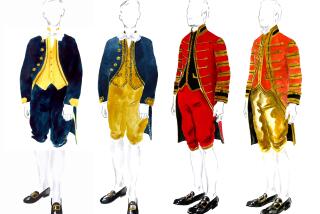INTERIORS : Research Is 1st Step Toward Any Look
- Share via
Decorating in a single authentic period style, whether it’s Renaissance Revival or Gothic, is a real pleasure once you get started, and the rewards are especially rich with an old house, says Mimi Findlay, a decorator and antiques dealer who has specialized in older homes.
Before settling on a period decor, Findlay suggests a three-stage program: researching, budgeting and shopping for materials and artisans who know how to install the furnishings.
While her experience centers on the older styles, the basic strategy can also be applied to more modern decors--such as Craftsmen or Streamline.
You begin to get a feel for the right thing by visiting houses from the time period, especially those that haven’t done a lot of restoration, she says. She also advises spending time studying period photographs.
For the older styles, reliable resources include “The Tasteful Interlude,” by William Seale, published in 1981. She also recommends searching secondhand bookshops or visiting the library for copies of Charles Eastlake’s “Hints on Household Taste” and Clarence Cook’s “The House Beautiful.” Both are popular advice books of the 19th and early 20th centuries.
Period decorating can be costly, especially if you want antique furniture rather than reproductions. If one of the formal Victorian and Aesthetic schemes so beloved in the 19th Century is too pricey, she suggests switching to a more countrified scheme that requires fewer elements and less costly furniture.
“I usually suggest to clients that we conform to the style of the house,” she says, “or if it’s a mixture of styles, as is so often the case, to the dominant theme or the one that they like best.”
It’s important to get the backgrounds right--the wallpaper, floor coverings, window coverings and ceilings--because these are the major elements of the room. There are some tricks to the trade.
“The 19th Century did not match colors exactly as we do,” Findlay says.
In addition, she says, they used a lot more gold than moderns would consider in good taste. Wallpaper and moldings were gilded, and gold threads were woven into upholstery.
They also mixed a variety of materials in one room. Side chairs were often done up in the same fabric, but each of the easy chairs might have a different covering.
Typical 19th Century wall treatment is complicated to the point of selecting and hanging up to nine patterns in one room. The lower wall, known as a dado, required one pattern, and the upper wall had another. Above that was a wide border known as a frieze. A narrow border where wall met ceiling, as well as several ceiling papers, were also common.
“The woodwork would not have been painted white but rather a fairly deep color,” Findlay says. “All the colors and patterns have to be worked out so they go together and, of course, the carpet and wall coverings have to be compatible.”
Get the backgrounds right, and the furniture will look its best.
Just as now, there were many options in furniture styles, from handmade to mass-produced and from formal to informal.
Furthermore, people used old pieces with new, just as they do today.
Feel free to mix reproductions and pieces that are earlier and later, and don’t be faint-hearted.
“Clients are likely to get alarmed when the woodwork is painted,” Findlay says. “When we add the complicated wall treatment, it’s worse.
“But it all comes right when the furniture goes in and the pictures go up, provided you have skill, a sense of color coordination and a certain amount of taste.”
